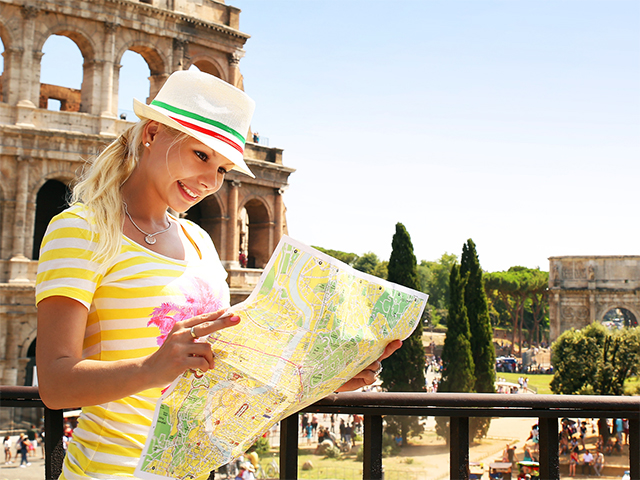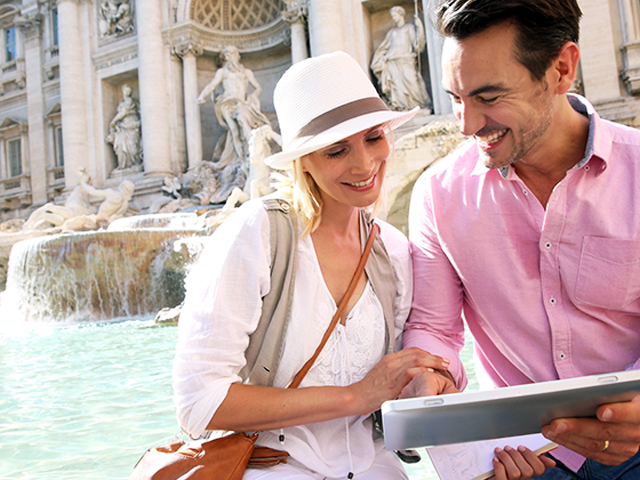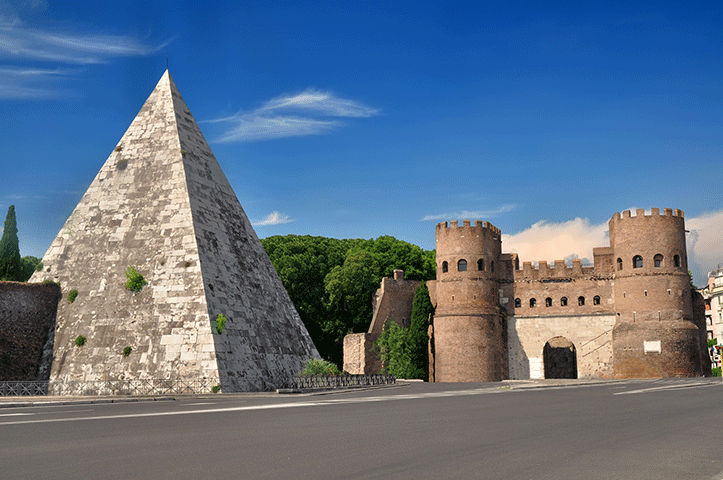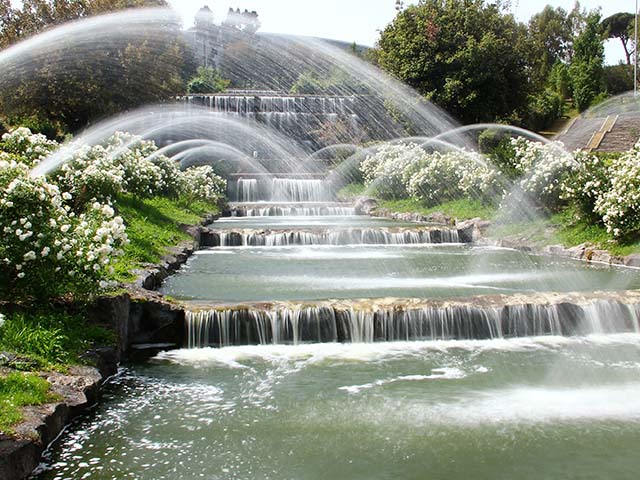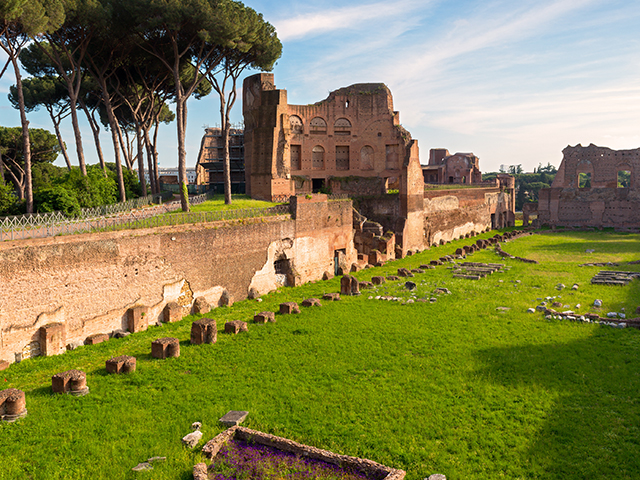Piazza di Spagna in Rome: how to get there and what to do
How to get there and what to do in Piazza di Spagna: history, monuments and pictures of one of Rome's most beautiful and elegant squares.Piazza di Spagna, with the staircase leading to the church of Trinità dei Monti, the fountain of la Barcaccia, the house museum of English poets Keats and Shelley and much more, is beyond doubt one of Rome's most beautiful and famous squares. Are you ready to dicover this extraordinary place?
THE SQUARE
Located at the bottom of the Pincio hill, Piazza di Spagna has always represented a hub for cultural and tourist life in the city of Rome. Artists and scholars have been hanging out here since the sixteenth century. The square is full of hotels, inns and elegant residential buildings, and it acquired its current appearence between the seventeenth and eighteenth centuries. Its name comes from Palazzo di Spagna, seat of the Spanish Embassy at the Holy See.
Among history, art and important shopping streets, Piazza di Spagna is still now one of the favourite destinations by tourist form all over the world, as well as by Romans, and it is an unmissable stop for any true visit.
Easily reachable by the metro stop with the same name, it is connected to Piazza del Popolo through Via del Babuino, one of the historic streets forming the so-called "trident". From the square, you can access the famous Via Condotti, with its boutiques and luxury shops, that rejoins also with Via del Corso, the Roman shopping center par excellence.
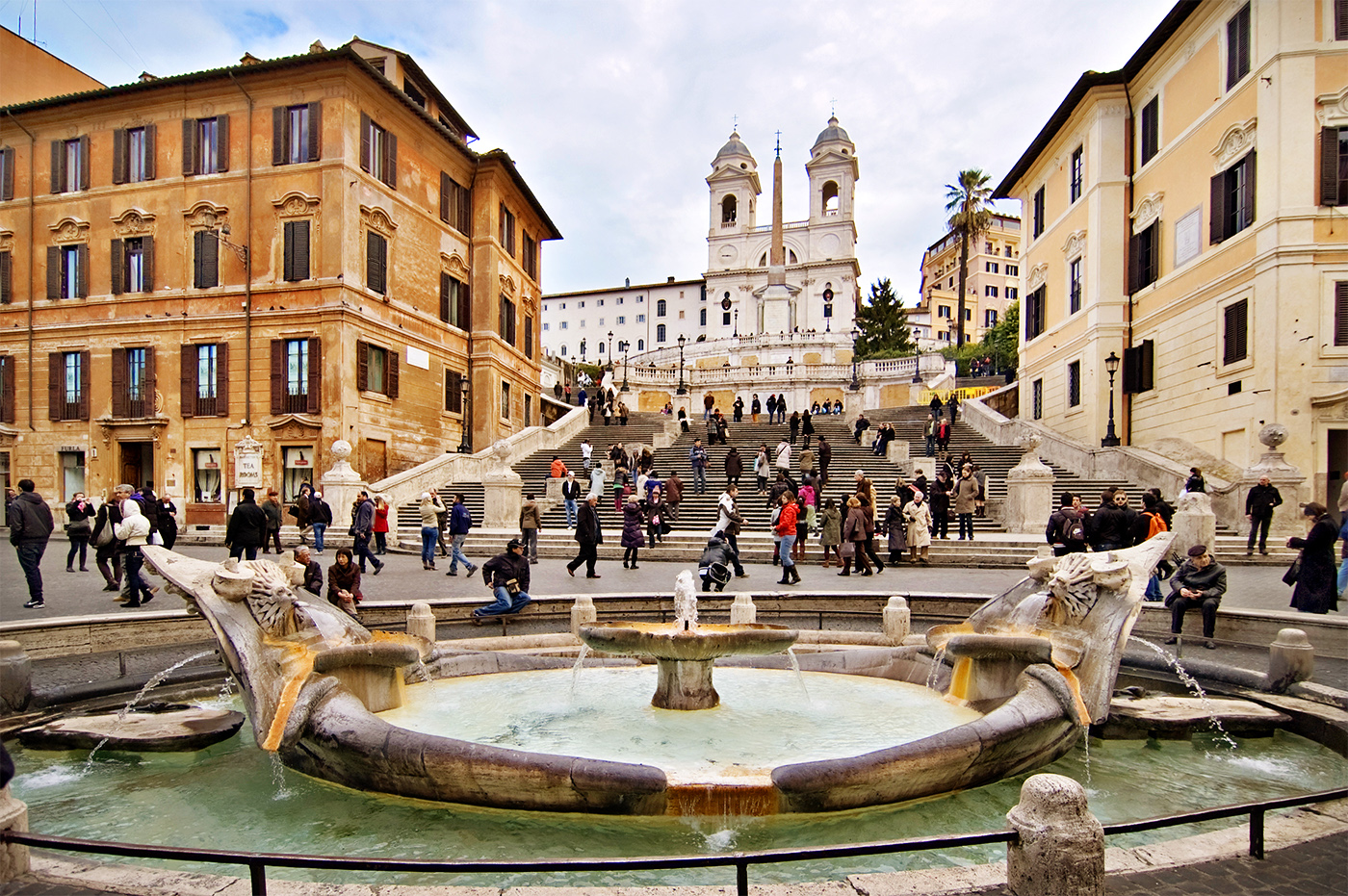
Piazza di Spagna with the famous fountain of la Barcaccia and the steps of Trinità di Monti - Wikipedia CC BY 3.0
PIAZZA DI SPAGNA: FONTANA DELLA BARCACCIA (Fountain of the Ugly Boat)
In the center of the square is placed the Barcaccia (Ugly Boat), one of Rome's most beautiful fountains.
Built in barroque style by Pietro and Gian Lorenzo Bernini in 1627 by commission of Pope Urban VIII, the fountain takes its name from the characteristic form of a boat sinking. Not many know that the work was inspired by the flood that caused the overflowing of the Tiber River in 1598. It is ingenously designed to make up for the lack of water pressure and it is located below the street level, as if it was half submerged.
The fountain is a favourite destination by tourists, who stop by to take a picture or just to drink from the drinkable water pouring from the prow or the stern of the boat.
Recently, in 19th February 2015, the fountain was unfortunately victim of a serious act of vandalism, by a group of Dutch supporters who caused scratches and chips in several points. And thinking that it had been recently completely restored and it looked more beautiful than ever!
PIAZZA DI SPAGNA: THE SPANISH STEPS
The monumental steps of Piazza di Spagna are an emblem spot in Rome. Built by will of Pope Benedict XIII between 1723 and 1725, they were unveiled under the papacy of Innocent XIII.
Formed by 12 flights and 135 steps made with travertine, the staircase includes several areas to rest. In fact, according to the original project by architect Francesco De Sanctis, the staircase, besides linking the church of Trinità dei Monti to the building of the Bourbon Spanish Embassy, was meant to be a meeting point.
Its wide terraces still today welcome millions of tourists and Romans who come here to spend an afternoon or an evening. When spring comes, the steps become even more beautiful, thanks to the traditional exhibition of Capitoline azaleas that are displayed all over the blooming period.

A panoramic view over Piazza di Spagna during the traditional exhibition of Capitoline azaleas
PIAZZA DI SPAGNA: TRINITÀ DEI MONTI
After refreshing in the fountain of la Barcaccia, climb all the steps up to the top and bring yourselves to the Pincio terrace: the astonishing views of the city seen from above are unique.
In top of the steps, you will find the Church of Trinità dei Monti with its two twin bell towers. Established in 1495 by the French, the church has been modified many times but it still maintains some traces of the original barroque style. The frescoes in the chapels in the interior were painted by Daniele di Volterra, the same artist to whom Pope Pius IV entrusted to cover the nudity of the characters in the Last Judgement of the Sistine Chapel and from that moment on he wasis nickname was "braghettone".
WHAT TO DO IN PIAZZA DI SPAGNA?
As you might have guessed, you won't run out of things to do and see in Piazza di Spagna!
In addition, if you still have time and you are a hopeless romantic, visit as well the Keats-Shelley House, located just right to the steps.
It is the last abode of the English poet John Keats, who died there in 1821 when he was only twentyfive years old. This house-museum contains a rich collection of paintings, sculptures, manuscripts, objects and first editions of works by Keats, Shelley and Lord Byron, relevant exponents of the English Romanticism.
The house includes as well a rich specialised library that counts with over eight thousand books and many are added frequently.
If instead you want to treat yourself, at the bottom of the steps, you will find Babington's, an elegant Tea Room in true English style established 120 years ago.
This room was established in 1893 by Isabel Cargill and Anna Maria Babington, as tea and reading room for the many Anglo-Saxons living in the city. The neat interior design reminds of London at the end of the nineteenth century, decorated by printing machines, paintings, old furniture and a hearth, lighted in the coldest days during winter.
The prices are anything but inexpensive, but if you love the magical English atmosphere and you feel like allowing yourself a small luxury, don't think longer about it and get in.
If you love art you can also visit the House Museum of Giorgio De Chirico in the seventeenth-century building called Palazzetto del Borgognoni in 31, Piazza di Spagna.
The abstract artist lived here the last thirty years of his life, together with his second wife Isabella Pakzswer Fa, who continue living ther until 1990, when she died. The museum, open in 1998, is meant to keep the painter's artistic heritage, hosting many relevant works.
You can visit the museum only under prior reservation ans it is closed on Mondays and Sundays. To book your visit and for further information, refer to the official site of the Foundation Giorgio and Isa De Chirico.
Close to Piazza di Spagna, in the adjacent Piazza Mignanelli in front of the Spanish Embassy in Rome, and next to Palazzo di Propaganda Fide there is the famous Column of the Immaculate Conception.
The work, designed by architect Luigi Poletti in 1857 and devoted to the dogma of the Immaculate Conception, professed in 1854 by Pope Pius IX, according to which the Virgin Mary is the only human being born free from the original sin.
The column of around 12 meters high rests over a structure formed by a base made with marble and it holds the statue in bronze of the Virgin, by Giuseppe Obici.
The 4 statues in bronze on the base represent Moses, David, Ezekiel and Isaiah and they were respectively made by Ignazio Jacometti, Adamo Tadolini, Carlo Chelli and Salvatore Revelli.
If you happen to be around on the 8th of December, the National Day devoted to the Immaculate Conception, the statue is presented with a flower chain with the presence of the Pope who blesses all the presents.

Column of the Immaculate Conception
Now that you have visited quite everything in the surroundings of Piazza di Spagna, we are sure you will naturally opt for continuing for a walk along Via dei Condotti, considered Rome's Fifth Avenue.
The relevant high fashion Italian and international brands gather here: Dolce&Gabbana, Salvatore Ferragamo, Louis Vuiton, Valentino, Laura Biagiotti, Prada, Gucci, Zagna, Tod’s and much more. In here, for many, going shopping it's just like they say "look but don't touch". If you can otherwise afford it, then, well, good for you!
Via Condotti will lead you in the end to Via del Corso, the other important arterial street for shopping in Rome, full of shops and brands that are more or less affordable by everyone. Read now our suggestions at the bottom of the page, with precious information to organise at best your own visit.
Useful information
Piazza di Spagna
- HOW TO GET THERE
Getting to Piazza di Spagna by public transport is easy and convenient. We advise against getting there by car, sinde the area is closed to traffic and it is not easy to find a parking spot in the surroundings of the square.
- From the Port of Civitavecchia: to get to Piazza di Spagna go to Civitavecchia Train Station and get on the first train bound for Rome. After one-hour trip, get off at Roma Termini Station and take the metro (line A) towards Battistini for 3 stops. Get off at Spagna and within a short walking distance you will be there.
- From Rome: if you are in Rome, the best way to get to Piazza di Spagna is always by metro, from the close station (line A). If you are nearby a stop of line B you can just get to Termini and change line.
- TIMETABLES
- Church of Trinità dei MontiTuesday - Sunday: 7.00 - 13.00 | 15.00 - 19.00
Monday: closed
*During the Holy Mass visiting the church is not allowed:
Mass hours: Workdays 9.00/11.00/18.30 | Holidays 12.30/18.30Keats-Shelley HouseMonday - Saturday: 10.00 - 13.00 | 14.00 - 18.00
Sunday: closedThe museum opens on some holidays (Italian and English), but in 2015 it will close on the 15th of August.For further information refer to the Keats-Shelley House official site.House Museum Giorgio De Chirico10.00-13.00: opening to public under prior reservation from Tuesday to Saturday and the first Sunday of the month.You can book your visit on the official site.Babington's Tea RoomAperto tutti i giorni dalle 10:00 alle 21:30 - PRICES
- Church of Trinità dei MontiFree admissionKeats-Shelley HouseFull: €5,00
Reduced: €4,00 (for visitors under 18 and over 65 years old)*For the reduced ticket a valid ID is required*Free admission for all children under 6 years oldHouse Museum Giorgio De ChiricoFull: €7,00Reduced: €5,00 (for visitors under 18 and over 65 years old)*Free admission for all children under 12 years old*Payment of the tickets will be directly at the museum on the day of the visit



 PORT MOBILITY CIVITAVECCHIA
PORT MOBILITY CIVITAVECCHIA









